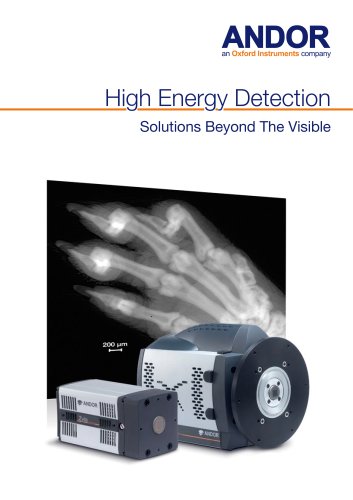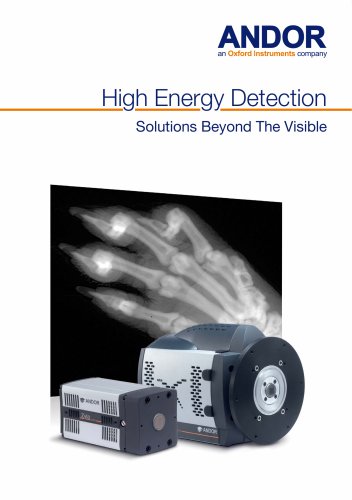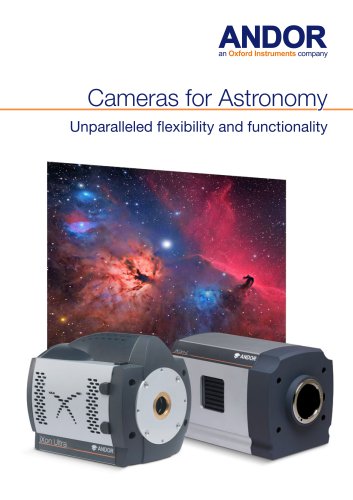
Catalog excerpts

ANDOR CAMERAS FOR ASTRONOMY Andor is the partner of choice for professional astronomers first and foremost due to the quality of our cameras. It places into the hands of the user a tool of unparalleled flexibility and functionality, which has been built into a robust and reliable framework. The hardware and software design allows seamless integration into a system of any complexity. It is therefore no surprise that when looking for a cutting edge, reliable camera to operate in some of the world’s most challenging conditions and sites, people look to Andor. Why ‘off-the-shelf’? Increasingly...
Open the catalog to page 2
r vice and Production Knowle We say we are driven; not only do we continually seek new challenges, we strive to improve what we presently offer. The most important motivation for this drive is the Andor user community. ANDOR DRIVEN TO EXCEL 1997 Introduce first vacuum technology which became UltraVac 1999 First dedicated imaging camera Large area camera, iKon-L 2007 Clara, the deepest cooled and most sensitive interline CCD iXon EMCCD Camera, introducing groundbreaking EMCCD technology Andor’s Added Value 2012 Introduction of EX2 Technology offering extended QE response RealGain and EMCal...
Open the catalog to page 3
CONSTELLATIONS OF ANDOR CAMERAS Which type of camera do I need? Typical Applications Applications that require a Large Solar Astronomy, Lucky Imaging, Field of View; on top of Fast Frame Speckle Imaging, Exoplanets, Rate, Low Noise, Temporal and Near Earth Objects [NEO] High Spatial Resolution. To help you choose we have listed the main attributes of the three different camera types along with some suitable applications. Zyla 5.5 sCMOS Neo 5.5 sCMOS Typical Applications Applications with low Photon Flux, demanding Fast Frame Rate with High QE and Temporal resolution Typically < 40 Photons...
Open the catalog to page 4
EMCCD TECHNOLOGY EMCCDs operate by amplification of weak signal events to a signal level that is well clear of the read noise floor of the camera, at any readout speed. Importantly, this ‘on-chip’ amplification process is realized without sacrificing the photon collection capability of the sensor. Back-illuminated sensors offer greater than 90% Quantum Efficiency (QE). The single photon sensitivity of EMCCDs renders them unbeatable in the low light regime of few to tens of incident photons per pixel. This may sound very low, but there are a surprising amount of applications that fall within...
Open the catalog to page 5
iXon EMCCD Range The iXon portfolio encompasses a number of model variations, offering solutions for a wide range of application requirements. Whether your ultrasenstive requirements need further refinement by demands on speed, resolution, field of view or wavelength dependence, the iXon series of market-leading EMCCD cameras will provide a solution. iXon Series Ultimate Sensitivity... Supercharged Ultimate Sensitivity Field of View and Sensitivity Lightning Speed and Sensitivity Pixel format Pixel size Frame rate 56 fps (595 fps with 128 x 128 cropped mode) 35 fps (395 fps with 128 x 128...
Open the catalog to page 6
Ultimate Sensitivity...Supercharged! The significant speed boost offered in the iXon Ultra 897 facilitates a new level of temporal resolution attainment. This is ideal for speed-challenged low-light applications such as Speckle Imaging, adaptive optics, Gamma Ray Bursts (GRB) and Lucky Imaging. The extremely low noise of the iXon Ultra 897, coupled with the new overclocked speed performance, will place this model at the forefront when it comes to upgrading any existing systems or building the latest cutting edge setup. Key Specifications Active pixels Active area pixel wall depth (e ) With...
Open the catalog to page 7
Field of View and Sensitivity Lightning Speed and Sensitivity The largest camera FOV of the EMCCD range, the iXon3 888 array size warrants its use in a dedicated imaging role. However, the iXon3 platform flexibility means this is more than a one trick camera. It has been used for many applications, including Solar Astronomy, where EMCCD and larger images where required. A camera for the full picture! Key Specifications Active pixels Pixel size (µm) Active area pixel wall depth (e ) Frame rate (fps; full frame) This incredible speed augment with the EM capability of the camera has made it...
Open the catalog to page 8
EMCCD Case Studies Flickering Aurora Earth-like Exoplanets High Temporal Resolution Measurement Gravitational Microlensing The beautiful light displays known as aurora occur when energetic charged particles collide with atoms in the high-altitude regions of the atmosphere. One type of aurora, known as flickering aurora, rapidly fluctuates in a manner similar to the reaction of a candle’s flame to a sudden draft of air. Researchers from Tohoku University in Japan used an Andor iXon Electron Multiplying CCD (EMCCD) astronomy camera to learn more about flickering aurora. This type of aurora...
Open the catalog to page 9
Scientific CMOS (sCMOS) is a breakthrough technology that offers an advanced set of features that render it ideal to high fidelity, quantitative scientific measurement, overcoming many of the performance drawbacks and trade-offs associated with CCDs. (SCIENTIFIC CMOS) sCMOS TECHNOLOGY This evolutionary camera is becoming the imager of choice for a gamut of astronomical applications. It is already popular with solar astronomers imaging the entire sun due to high spatial resolution and fast frame rates, enhancing observation of solar activities to realise new insights. The same camera can...
Open the catalog to page 10
sCMOS Case Studies Transit of Venus This incredibly high resolution image was taken of Venus just as it began its transit across the face of the sun. The single frame was taken from a continuous observation run of the 2012 transit of Venus. It was captured at Hawaii’s Subaru Telescope, using a Zyla camera. The transit of Venus is a beautiful but rare event, due to the orbits of the planets, with the next occurrence on the 10–11th December 2117. It has a historical status in the annals of astronomy because observations taken during the 1639 transit allowed the solar system to be measured....
Open the catalog to page 11All Andor Technology catalogs and technical brochures
-
Marana sCMOS
9 Pages
-
MicroPoint 4
9 Pages
-
ZL41 Cell sCMOS
7 Pages
-
Sona sCMOS
9 Pages
-
Optistat
11 Pages
-
Multi-Wavelength Imaging
11 Pages
-
BC43
13 Pages
-
andor-kymera-193-specifications
15 Pages
-
andor-dragonfly-specifications
14 Pages
-
Solis-Brochure
6 Pages
-
Spectroscopy-Solutions-Brochure
24 Pages
-
iKon-M/L SO Series
10 Pages
-
iStar CCD and sCMOS
8 Pages
-
Neo 5.5 sCMOS
6 Pages
-
Mechelle 5000
5 Pages
-
Cameras for Astronomy
8 Pages
-
Microspectroscopy Gatefold
8 Pages
-
Spectroscopy Brochure
25 Pages
-
Apogee Alta F9000
5 Pages
-
Apogee Aspen CG230
5 Pages
-
Apogee Aspen CG47
5 Pages
-
Apogee Aspen CG6
5 Pages
-
ApogeeAspen CG9000
5 Pages
-
iXon EMCCD
13 Pages
-
Zyla for Physical Sciences sCMOS
12 Pages
-
iVac OEM 2
2 Pages
-
iKon-M OEM 2-page PV
2 Pages
-
iKon-M X-Ray 2
2 Pages
-
Newton EMCCD
16 Pages
-
iQ Software
12 Pages
-
sCMOS
16 Pages
-
Luca vs Interline CCD
6 Pages
-
Low Light Imaging
8 Pages
-
Darkcurrent
3 Pages
-
iXon Back-illuminated
6 Pages
-
Revolution
23 Pages
-
High Energy Detection_2014
28 Pages
-
Clara Flyer
2 Pages
-
PRODUCT PORTFOLIO 2013
51 Pages
-
Andor Revolution XD brochure
23 Pages
-
Revolution DSD
11 Pages
-
Active Illumination Solutions
25 Pages
-
Clara Interline CCD Series
2 Pages
-
Intensified Camera Series
9 Pages
-
Neo and Zyla sCMOS
27 Pages
-
iXon
33 Pages
Archived catalogs
-
High Energy Detection_2019
8 Pages
-
Astronomy Brochure_2014
19 Pages
-
iKon-M USB X-Ray Brochure
2 Pages

























































